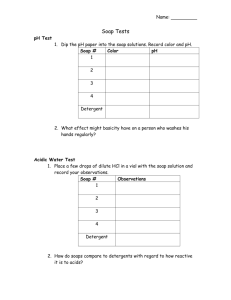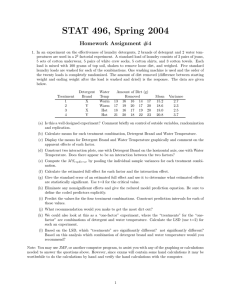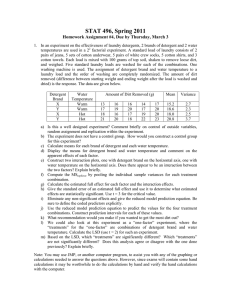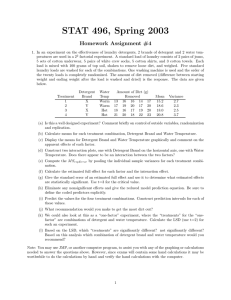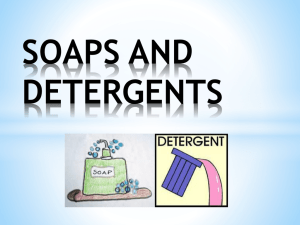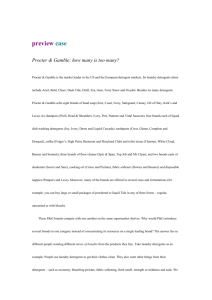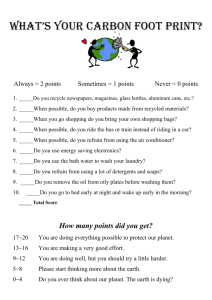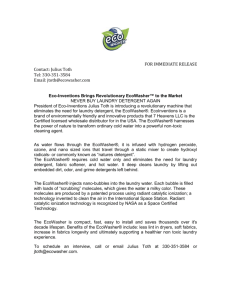Document 14670823
advertisement
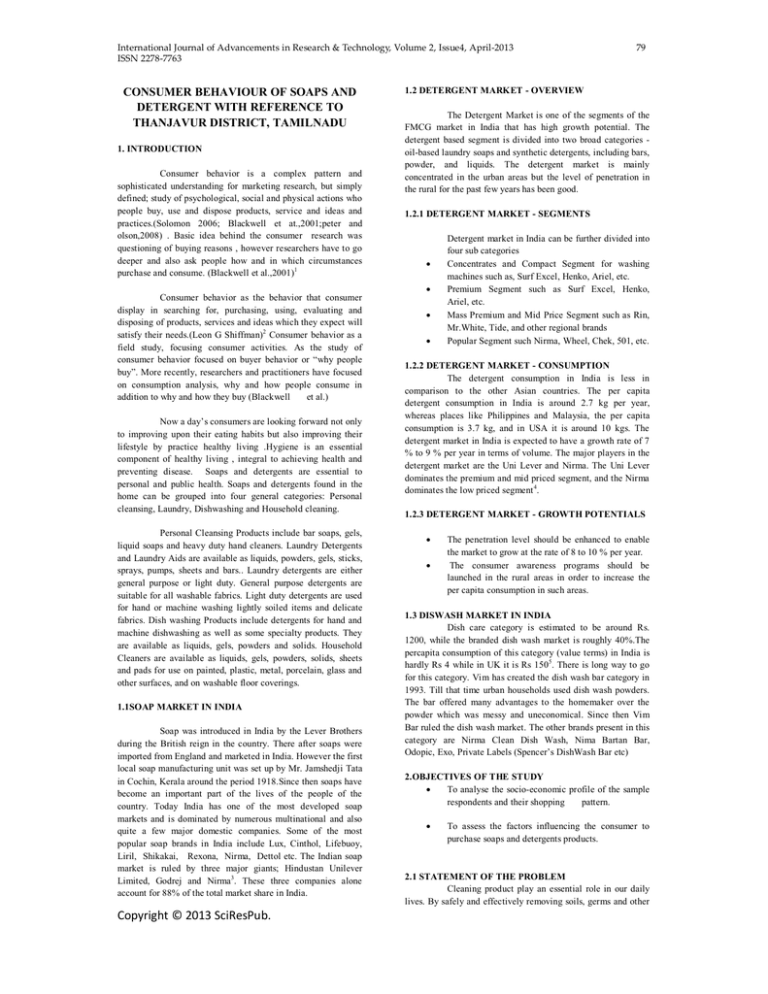
International Journal of Advancements in Research & Technology, Volume 2, Issue4, April-2013 ISSN 2278-7763 CONSUMER BEHAVIOUR OF SOAPS AND DETERGENT WITH REFERENCE TO THANJAVUR DISTRICT, TAMILNADU 1. INTRODUCTION Consumer behavior is a complex pattern and sophisticated understanding for marketing research, but simply defined; study of psychological, social and physical actions who people buy, use and dispose products, service and ideas and practices.(Solomon 2006; Blackwell et at.,2001;peter and olson,2008) . Basic idea behind the consumer research was questioning of buying reasons , however researchers have to go deeper and also ask people how and in which circumstances purchase and consume. (Blackwell et al.,2001)1 Consumer behavior as the behavior that consumer display in searching for, purchasing, using, evaluating and disposing of products, services and ideas which they expect will satisfy their needs.(Leon G Shiffman)2 Consumer behavior as a field study, focusing consumer activities. As the study of consumer behavior focused on buyer behavior or “why people buy”. More recently, researchers and practitioners have focused on consumption analysis, why and how people consume in addition to why and how they buy (Blackwell et al.) Now a day’s consumers are looking forward not only to improving upon their eating habits but also improving their lifestyle by practice healthy living .Hygiene is an essential component of healthy living , integral to achieving health and preventing disease. Soaps and detergents are essential to personal and public health. Soaps and detergents found in the home can be grouped into four general categories: Personal cleansing, Laundry, Dishwashing and Household cleaning. Personal Cleansing Products include bar soaps, gels, liquid soaps and heavy duty hand cleaners. Laundry Detergents and Laundry Aids are available as liquids, powders, gels, sticks, sprays, pumps, sheets and bars.. Laundry detergents are either general purpose or light duty. General purpose detergents are suitable for all washable fabrics. Light duty detergents are used for hand or machine washing lightly soiled items and delicate fabrics. Dish washing Products include detergents for hand and machine dishwashing as well as some specialty products. They are available as liquids, gels, powders and solids. Household Cleaners are available as liquids, gels, powders, solids, sheets and pads for use on painted, plastic, metal, porcelain, glass and other surfaces, and on washable floor coverings. 1.1SOAP MARKET IN INDIA Soap was introduced in India by the Lever Brothers during the British reign in the country. There after soaps were imported from England and marketed in India. However the first local soap manufacturing unit was set up by Mr. Jamshedji Tata in Cochin, Kerala around the period 1918.Since then soaps have become an important part of the lives of the people of the country. Today India has one of the most developed soap markets and is dominated by numerous multinational and also quite a few major domestic companies. Some of the most popular soap brands in India include Lux, Cinthol, Lifebuoy, Liril, Shikakai, Rexona, Nirma, Dettol etc. The Indian soap market is ruled by three major giants; Hindustan Unilever Limited, Godrej and Nirma3. These three companies alone account for 88% of the total market share in India. Copyright © 2013 SciResPub. 79 1.2 DETERGENT MARKET - OVERVIEW The Detergent Market is one of the segments of the FMCG market in India that has high growth potential. The detergent based segment is divided into two broad categories oil-based laundry soaps and synthetic detergents, including bars, powder, and liquids. The detergent market is mainly concentrated in the urban areas but the level of penetration in the rural for the past few years has been good. 1.2.1 DETERGENT MARKET - SEGMENTS Detergent market in India can be further divided into four sub categories Concentrates and Compact Segment for washing machines such as, Surf Excel, Henko, Ariel, etc. Premium Segment such as Surf Excel, Henko, Ariel, etc. Mass Premium and Mid Price Segment such as Rin, Mr.White, Tide, and other regional brands Popular Segment such Nirma, Wheel, Chek, 501, etc. 1.2.2 DETERGENT MARKET - CONSUMPTION The detergent consumption in India is less in comparison to the other Asian countries. The per capita detergent consumption in India is around 2.7 kg per year, whereas places like Philippines and Malaysia, the per capita consumption is 3.7 kg, and in USA it is around 10 kgs. The detergent market in India is expected to have a growth rate of 7 % to 9 % per year in terms of volume. The major players in the detergent market are the Uni Lever and Nirma. The Uni Lever dominates the premium and mid priced segment, and the Nirma dominates the low priced segment 4. 1.2.3 DETERGENT MARKET - GROWTH POTENTIALS The penetration level should be enhanced to enable the market to grow at the rate of 8 to 10 % per year. The consumer awareness programs should be launched in the rural areas in order to increase the per capita consumption in such areas. 1.3 DISWASH MARKET IN INDIA Dish care category is estimated to be around Rs. 1200, while the branded dish wash market is roughly 40%.The percapita consumption of this category (value terms) in India is hardly Rs 4 while in UK it is Rs 1505. There is long way to go for this category. Vim has created the dish wash bar category in 1993. Till that time urban households used dish wash powders. The bar offered many advantages to the homemaker over the powder which was messy and uneconomical. Since then Vim Bar ruled the dish wash market. The other brands present in this category are Nirma Clean Dish Wash, Nima Bartan Bar, Odopic, Exo, Private Labels (Spencer’s DishWash Bar etc) 2.OBJECTIVES OF THE STUDY To analyse the socio-economic profile of the sample respondents and their shopping pattern. To assess the factors influencing the consumer to purchase soaps and detergents products. 2.1 STATEMENT OF THE PROBLEM Cleaning product play an essential role in our daily lives. By safely and effectively removing soils, germs and other International Journal of Advancements in Research & Technology, Volume 2, Issue4, April-2013 ISSN 2278-7763 contaminants, they help us to stay healthy care for our homes and possessions and make our surroundings more pleasant. Soaps and Detergent plays an important role in FMGC sector. The overall soap penetration in Indian household is 98%.Compare to other sectors investors prefer to make their investment in this sector only. However there is high growth tendency for FMCG sector it faces some difficulties in achieving their destination. Hence the purpose of this study is to identify the force that influence on consumer shopping pattern particularly in Thanjavur. Soaps and detergents are used by each one in their day today life, that’s why the reason behind to select the particular product for the study. 2.2 SCOPE OF THE STUDY The present study target of consumers in Thanjavur district, understanding their behaviour helps to identify the preference influence of brand in their purchase decision etc on the purchase of soaps and detergents. The insight will help the manufactures to adopt new strategies which would help not only to attract new customer but also maintain the loyalty of the existing customer, as in the present competitive scenario the consumer are prepared to choose their right product not only based on their needs but also on the basis of personal interest shown by the manufactures on them. 2.3 LIMITATIONS OF THE STUDY The research concentrates only toilet soap, laundary detergent and dishwashing bar. 400 respondents are taken for the study.with the income in sample size the result may vary. 2.4 REVIEW OF LITRATURE FRANCIES GNANASEKAR6 (1997) in his study titled “A study on brand positioning of detergent soaps and powders in Thiruchirapalli District” suggested that the manufacturers of various brands should take necessary steps to ascertain the position of their brands. RABIA JAHANI FARZANA7 (2008), “Study on sales promotion activities for toilet soaps and their impact on purchase behavior in Thirichirapalli district” explained the lifestyle and attitude of consumers on their purchase behavior and various sales promotion activities adopted by manufacturers for marketing their product. 8 THIRUMOORTHY P and KARTHIKEYAN P , in their study, “A Study on retailer and customer attitude towards P&G detergent powder in Coimbatore city” found that the consumers are influenced by major factors such as brand name, price ,quality, availability, packaging, advertisements, etc. during the purchase decision. The study also suggest advertisement plays an important role for selection of a particular brand of detergent powder. GIHAN WIJESUNDERA9 (2010) in this article “Factors influencing the demand of beauty soap among female consumers in the greater Colombo region” Purpose of this study is to explore how the marketing mix & demographical factors influence the brand preference & purchasing behavior of beauty soap among the female consumers in the greater Colombo region. The results indicated that there were statistical relationships between price, product, education, occupation and band preference and there was no statistical relationship Copyright © 2013 SciResPub. 80 between place, promotion, age, income level, marital status, skin type, social factors, and substitute product with the brand preference. Thus the research concludes that the price, product, education & occupation are only having a statistical relationship with the brand preference of female consumers in the greater Colombo region. NUNTASAREE SUKAT10 (2009) in this article “A model of male consumer behaviour in buying skin care products in Thailand” The study purpose of the research was evaluated in some depth the phenomena of male consumer behaviour in buying skin care products in Thailand. In order to cope with the research purpose, Fishbein and Ajzen’s theory of reasoned action model is employed as a theoretical framework and modified by adding the self-image construct. The research objective was find out the “To what extent do beliefs in product attribute, self-image, Normative influences, and attitudes toward applying skin care products, affect Thai male consumers’ purchase intention and purchase behaviour in buying skin care products. The researcher was find out the result or confirm that beliefs, self-image, normative influences, and attitudes have impacts on purchase intention and purchase behaviour in buying skin care products among Bangkok male consumers. 3. RESEARCH METHODOLOGY 3.1 Research Design This research is descriptive in nature as the study aims to find out the consumer behavior about soaps and detergents. The study is carried out the naturalistic observation and survey questioning, which are attributes of descriptive research. 3.2 Data Collection technique Collection of data for the purpose of the research study is in the form of primary data and secondary data, as the study being empirical in nature. Primary data includes expert’s suggestions, executive’s opinion, face-to-face interviews, and survey questionnaires. Questionnaires were collected based on the sampling technique from consumer behaviour about Soaps and Detergents. The interviews that took take place with the consumer. Further, secondary data sources include focus group transcripts, observation records, research related documents, published books, article, newspapers, published and unpublished research work of various institutions. 3.3 Designing the Questionnaire Questionnaire is designed by the researcher in such a way that there are several questions designed on the basis of scaling namely Likert Scales which have five scales like strongly agree, agree, neutral, disagree, strongly disagree. This enables the respondent to answer the questions in a structured manner by choosing one option among the five options. It provides a sense of comfort by choosing the precise answers. Each construct has minimum five sub constructs related to the key factor of the main construct . 3.4 Sampling Design The sampling technique involved is Convenient Sampling. This study conducted in various place in Thajavur district and as the population is very high the researcher couldn’t conduct a census study. Due to time constraint convenient sample was followed. 3.5 Sample size of the study 3.5.1 Sample size identification International Journal of Advancements in Research & Technology, Volume 2, Issue4, April-2013 ISSN 2278-7763 81 Here are the formulas used in our Sample Size Calculator: Table 1.2 Respondents brand of Toilet soap Sample Size Z P 1 P C2 2 Ss S.No. Where: Z = Z value (e.g. 1.96 for 95% confidence level) p = percentage picking a choice, expressed as decimal 1. Name of the product Lux Frequency Percentage 44 11 2. Cinthol 72 18 3. Hamam 84 21 4. Lifebuoy 56 14 5. Dettol 40 10 6. Pears 32 8 7. Dove 26 6.5 8. Medimix 20 5 9. Rexona 16 4 10. Vivel 10 2.5 Total 400 100 (.5 used for sample size needed) c = confidence interval, expressed as decimal (e.g., .04 = ±4) Determine Sample Size Confidence Level: 95% 99% Confidence Interval: 0.5% Population: 2,402,781 (as per 2011 census) Sample size needed 351(round off near hundred) Statistical tool applied Questionnaires were distributed and 400 samples were collected from the consumer. The verbal data in these questionnaires were transformed into numerical data using a software application called PASW statistics 18. Further, all the questionnaires were entered as values and different statistical tools like Percentage Analysis, and Mean Score. Source: Primary data Table 1.2 shows various brands of Toilet soap used by the respondent. The above Table shows that majority of the respondent(21%) used Hamam soap then followed by Cinthol (18%) and Lux (11%). Table 1.1 Demographic profile of the respondent S.No. Particular Classification 1. Gender 2. Age 3. 4. Educational level Monthly Income Frequency Percentage Male Female 168 232 42 58 18-28 29-38 39-48 49-58 132 124 88 56 33 31 22 14 5% 4% 2.5% 20 104 136 100 40 5 26 34 25 40 Below Rs.5000 Rs.5000- 15000 Rs.15001-25000 Above Rs.25000 32 88 112 168 8 22 28 42 Source: Primary data From the above table 1.1 it is inferred that majority of the respondent(58%) are female and belong to the age group of 18-28 (33%) and who have completed their higher education (34%) and earn monthly income above Rs.25000.(42%) Lux 11% Cinthol 6.5% 18% 8% No Formal education School level UG PG Above PG Copyright © 2013 SciResPub. Respondents brand of Toilet soap Hamam Lifebuoy Dettol 10% Pears 14% 21% Dove International Journal of Advancements in Research & Technology, Volume 2, Issue4, April-2013 ISSN 2278-7763 Table 1.3 Respondents brands of Laundry detergent Table 1.4 Respondents brands of dishwashing bar S.No S.No Frequency 1. Name of the product Power 64 2. Surf Excel 74 82 1. Name of the product Vim 16 2. Pril 18.5 3. Exo Percentage Frequency Percentage 168 42 120 30 Total 3. Wheel 52 13 4. Rin 88 22 5. Tide 50 12.5 6. Sunlight 36 9 7. Challenge 20 5 8. Urvasi 16 4 400 100 Total 112 28 400 100 Source : Primary data Table 1.4 shows various brands of dishwashing bar used by the consumer. Vim possessed top most rank(42%) in the dishwashing segment. Respondents brands of dishwashing bar Source : primary data 28% Table 1.3 Shows various brands of Laundry Detergent used by the consumer. Through the table Rin detergent possessed 22% of the respondent as a highest in the rank then Surf Exel(18.5%), Power(16%) and so on. 42% Vim Pril Exo 30% Respondents brands of Laundry detergent Table 1.5 Factors influencing Buying decision of respondent regard to Toilet Soap, Laundry Detergent and Dishwashing bar. Power 16% 9% Surf Excel Name of the Garret Score Rank Garret Score Challenge Urvasi Dishwashing Bar Rank 13% Laundry detergent 1 Brand Name 62.36 1 62.67 1 62.83 2 Quality 57.02 2 57.07 2 56.50 3 Quantity 55.13 3 55.04 3 55.27 4 Price 54.79 4 55.01 4 57.21 5 Easy availability 53.37 5 53.27 5 52.18 6 Package 49.88 6 50.33 6 49.02 7 45.60 7 46.02 7 47.42 43.42 8 42.28 8 43.62 8 9 Trade Name Date of Manufacturing Transparent 1 3 4 2 5 6 7 40.57 9 39.39 9 39.46 10 Affordability 36.43 10 36.68 10 36.86 9 10 Factors influencing Sunlight 22% product S.No 18.5%Rin Tide 12.5% Toilet soap Garrett Score Wheel 8 Source : Primary Data From the above table 1.5 brand name is the most important factor influencing the consumer to make purchase decision. Copyright © 2013 SciResPub. Rank 5% 4% International Journal of Advancements in Research & Technology, Volume 2, Issue4, April-2013 ISSN 2278-7763 83 care products in Thailand.ABAC Journal Vol. 29, No. 1 (January-April 2009, pp.39-52). FINDINGS, SUGGESTIONS AND CONCLUSION PUBLISHED &UNPUBLISHED RECORDS 1. 2. 3. 4. Through the study of consumer behavior of soaps and detergents most of the consumers make purchase decision on the basis of brand name, quality and their prices. So that the management should position their brand in a better way and to achieve quality and fix reasonable prices by proper training and development. There are lot of competitors in the soap and detergent market so that the manufacturers are required to promote various sales promotional activities to survive in the market. Introduce different package design and size to retain the existing consumer and attract new consumer. Suitable channels are required to sustain the market. 1. 2. 3. 4. 5. CONCLUSION The Indian soap and detergent market is characterized by immense competition and high penetration levels. As a result of rapid urbanization the demand for better quality household product is constantly on a rise. There is a tremendous opportunity for the branded and quality product at a reasonable price to consumer. REFERENCES 1. 2. 3. 4. 5. 6. 7. 8. 9. 10. Roger D. Blackwell, Paul W.Miniard, James F. Engel “consumer behavior” Harcourt college publishers. 9th Edition pp-7 Leon g schiffman Leslie lazar kanuk, “consumer behavior” Prentice Hall of private limited, Eight edition, 2003 pp.8 www.businessmapesofindia.com www.fmcgmarketers.com www.consumersreports.org Franciesgnanasekar (march 1997) “A Study on brand positioning of detergent soaps and powders in thiruchirapalli district” Phd dissertation,Bharathidasan university, trichy, Tamilnadu,india Rabiajahanifarzana(2008), “Study on sales promotion activities for toilet soaps and their impact on purchase behavior in Thirichirapalli district”Phd desertation, Bharathidasan university. Trichy,Tamilnadu,india. Thirumoorthy P, Karthikeyan P, in their study, “A Study on retailer and customer attitude towards P&G detergent powder in Coimbatore city” Indian Journal of marketing, vol XXXXVI, No.9, Sep 2006. Pp2631. GihanWijesundera (2010) Factors influencing the demand of beauty soap among female consumers in the greater Colombo region. ICBI 2010 - University of Kelaniya, Sri Lanka. NuntasareeSukat (April 2009) in this article “A model of male consumer behaviour in buying skin Copyright © 2013 SciResPub. Jacob Jacoby, “consumer psychology: An octennium” , in eds. Paul Muussen and mark Rosenzweig, Annual Review of psychology, 1976, pp.331-58. MorrisB.Holbrook, “what is consumer research?” Journal of consumer research, June 1987, pp128-132; RusellW.belk, “Manifest for a consumer behavior of consumer behavior,” scientific method in marketing, 1984, AMA winter Educators conference. Jonathan Arndt, “Role of product related conversations in the diffusion of a new product”, Journal of marketing research, August 1967, pp29195. Peter E. Drucker, The practicance of management (New York: Harper & Raw, 1954), p-37 Slash Hassan and Roger Blackwell, “Global marketing perceptive and cases”, Dryden press 1994. P-53. TEXT BOOKS 1. Roger D. Blackwell, Paul W.Miniard, James F. Engel “consumer behavior” Harcourt college publishers. 9th Edition 2. Leon g schiffman Leslie lazar kanuk, “consumer behavior” Prentice Hall of private limited, Eight edition,
